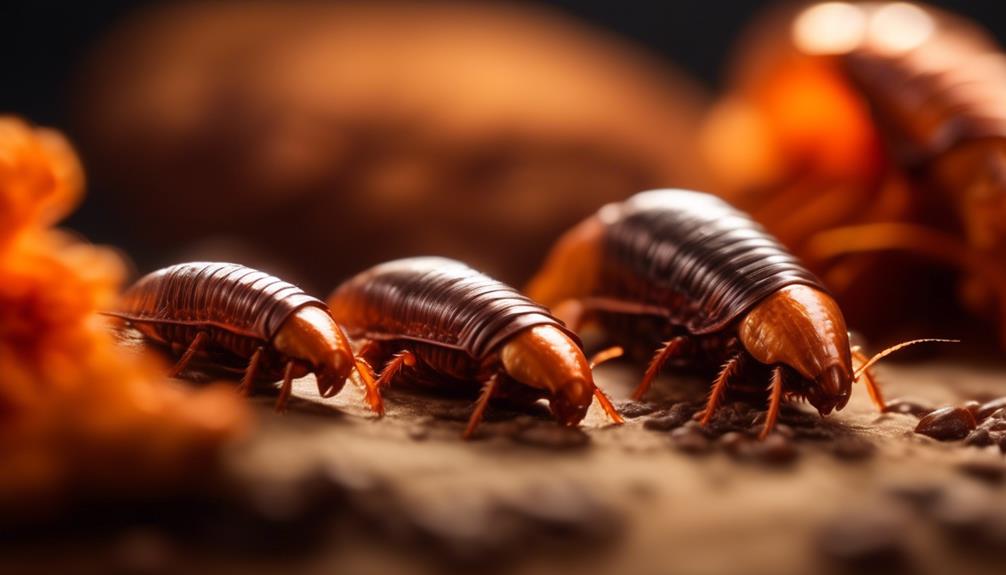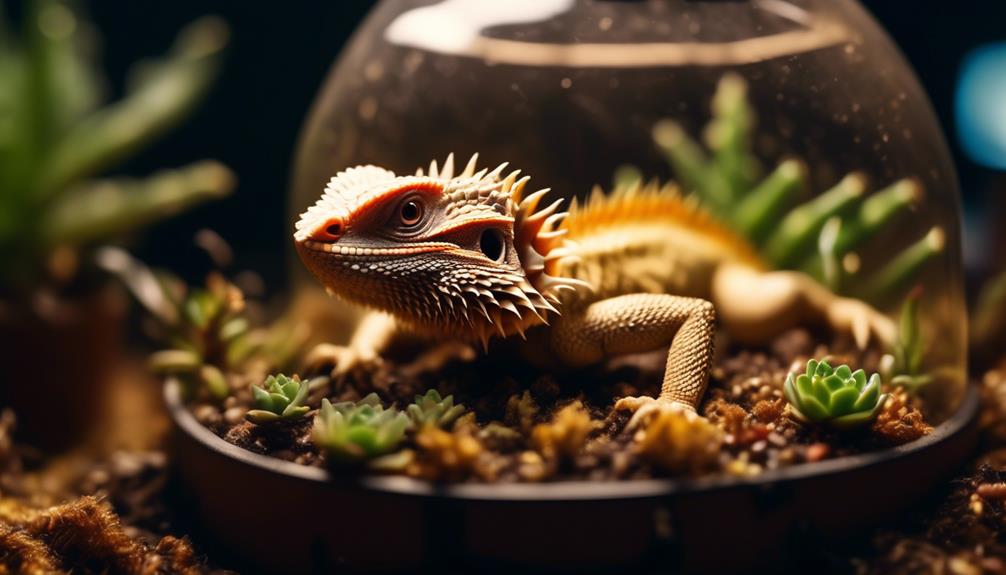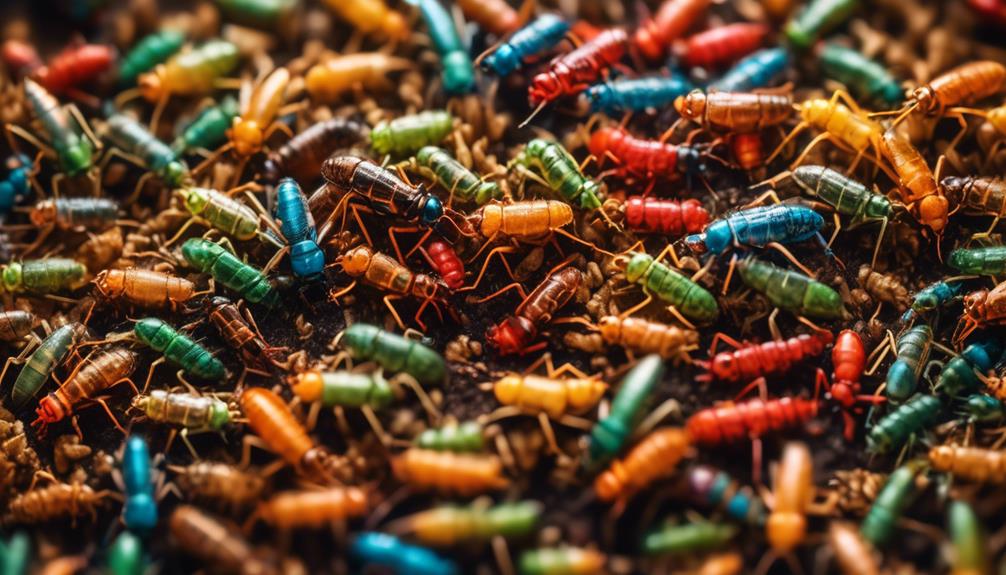Are you tired of your dragon's diet being as predictable as a broken record? Well, prepare to shake things up and give your scaly friend a culinary adventure like never before.
We're here to introduce you to a world of top feeder insects that will revolutionize your dragon's meals. These little critters pack a punch when it comes to nutrition and variety, and we can't wait to share all the juicy details with you.
So, get ready to tantalize your taste buds and embark on a journey that will leave both you and your dragon hungry for more.
Key Takeaways
- Dubia roaches are an excellent source of protein with a balanced range of nutrients and little to no smell or noise.
- Goliath worms (horned/hornworms) have a fast growth rate and high moisture content, making them a great source of nutrition and hydration boost, but they should not be fed as the sole staple.
- Waxworms have a high-fat content and should be fed in moderation, especially for dragons with weight problems. They are easy to store and keep.
- Superworms can be fed to dragons of any age and are easier to digest due to their softer outer shell. They should be fed alongside another staple feeder.
Dubia Roaches

Dubia roaches, widely regarded as an excellent feeder insect for bearded dragons due to their high protein content and balanced range of nutrients, are a popular choice among reptile enthusiasts. These roaches offer numerous benefits when included in a dragon's diet.
They provide a rich source of protein, which is essential for the growth and development of these reptiles. Additionally, they've a low-fat content, making them a healthy option.
Proper care for dubia roaches involves maintaining a suitable environment for breeding and growth. They require a warm and humid habitat, with temperatures ranging between 80-90°F and humidity levels around 60-70%.
A nutritious diet consisting of fresh fruits and vegetables, as well as a water source for hydration, is necessary to ensure the health of the roaches. Regular cleaning of their enclosure is also crucial to prevent odor and disease.
Goliath Worms (Horned/Horn Worms)
Goliath worms, also known as horned worms, are a highly nutritious feeder insect that can be a valuable addition to a bearded dragon's diet. These worms offer several benefits when incorporated into a balanced dragon diet:
- High Nutritional Value: Goliath worms are packed with essential nutrients that are beneficial for the overall health of bearded dragons. They're rich in protein, vitamins, and minerals, providing a well-rounded source of nutrition.
- Hydration Boost: Goliath worms have a high moisture content, making them an excellent option to help maintain hydration in bearded dragons. This is especially important for dragons that may not drink water regularly.
When incorporating goliath worms into a dragon's diet, it's important to follow these tips:
- Moderation: Goliath worms shouldn't be fed as the sole staple, but rather as a part of a varied diet. They should be offered alongside other feeder insects to ensure a balanced nutritional intake.
- Proper Sizing: Bearded dragons require appropriately sized prey items. It's essential to select goliath worms that are suitable for the dragon's size to prevent choking or digestive issues.
Waxworms

Waxworms, a popular feeder insect among bearded dragon owners, offer a high-fat content and are a convenient option to include in a varied diet for these reptiles. However, it's important to note both the benefits and potential drawbacks of feeding waxworms to your dragon.
Benefits of feeding waxworms include their high-fat content, which can provide a valuable source of energy for your dragon. Additionally, waxworms are easy to store and keep, making them a convenient choice for reptile owners.
On the other hand, there are potential drawbacks to consider when feeding waxworms. These insects shouldn't be fed as a sole staple in your dragon's diet, as they lack certain essential nutrients. It's also important to avoid feeding waxworms if your dragon has weight problems, as their high-fat content can contribute to weight gain.
Superworms
Superworms, also known as Zophobas morio, are a popular and nutritious feeder insect for bearded dragons. When considering their nutritional benefits and drawbacks, it's important to note that superworms have a slightly high-fat content. However, they can still be fed to dragons of any age and are easier to digest due to their softer outer shell.
It's recommended to feed superworms alongside another staple feeder to ensure a balanced diet. When incorporating superworms into a bearded dragon's diet, it's crucial to follow feeding guidelines and best practices. These include providing the appropriate size of superworms for dragons, offering them as a part of a varied diet, and not relying solely on superworms as the main food source.
Mealworms

When considering the range of feeder insects available for a bearded dragon's diet, it's important to discuss the nutritional benefits and considerations of mealworms. Mealworms are a commonly used feeder insect due to their accessibility and affordability. They're high in protein, making them a valuable source of nutrition for bearded dragons.
However, there are potential issues with feeding mealworms to bearded dragons. Mealworms have a hard outer layer called chitin, which can be difficult to digest, especially for young dragons. Therefore, it's recommended to feed mealworms as part of a varied diet and limit the intake to 5-6 per day for adult dragons.
It's advisable to avoid feeding mealworms to younger dragons until they've fully developed their digestive system. Overall, while mealworms can be beneficial for bearded dragons, it's important to feed them in moderation and consider the potential challenges they may pose to digestion.
Frequently Asked Questions
Can I Feed Dubia Roaches to My Dragon as Their Sole Staple Diet?
Feeding dubia roaches as the sole staple diet for dragons has pros and cons. While they provide excellent protein and balanced nutrients, it's important to include variety for a balanced diet.
Are Goliath Worms Suitable for Younger Dragons?
Goliath worms, with their high nutritional value, can be suitable for younger dragons. However, there may be potential risks and drawbacks, such as the need for a balanced diet and not relying solely on goliath worms as a staple.
How Many Waxworms Should I Feed My Dragon per Day?
When considering waxworms in a varied dragon diet, it's important to feed them in moderation, around 2-3 per day. Benefits include high-fat content and easy storage. Tips for picky eaters: introduce gradually and alongside other staple feeders.
Can Superworms Be Fed to Dragons of Any Age?
Feeding superworms to dragons of any age has its pros and cons. They are easier to digest than mealworms, but still have a slightly high-fat content. It is best to feed them alongside another staple feeder for a balanced diet.
How Many Mealworms Should I Feed My Adult Dragon per Day?
We should limit mealworms to 5-6 per day for adult dragons. They have a hard outer layer that can be difficult to digest, especially for young dragons. It's important to feed them as part of a varied diet.
Conclusion
In conclusion, by incorporating these top feeder insects into your dragon's diet, you can truly revolutionize their nutrition and overall health.
Whether you choose the protein-rich Dubia Roaches or the versatile Superworms, each feeder insect offers a unique set of advantages and considerations.
Remember to provide a balanced diet for your dragon and consider the benefits of alternative feeders like Black Soldier Fly Larvae or Silkworms.
With these options, your dragon will thrive and enjoy a varied and nutritious diet.
So, go ahead and elevate your dragon's meals to new heights!

